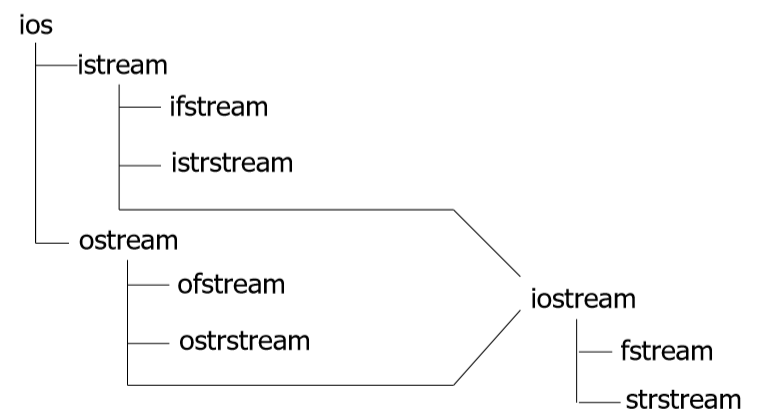输入输出流:包含在头文件<iostream>中 开头需要进行#include<iostream> 对象 功能 istream:cin 处理输入 ostream:cout 处理输出 ostream:cerr 处理错误 ostream:clog 保证log
程序的输入都键入一个缓冲区,即输入缓冲区。 键盘输入结束后,会将数据存入缓冲区,之后cin函数直接从输入缓冲区取数据 问题在于:缓冲区中有残留数据的时候,cin输入流直接从缓冲区拿数据。 >>是流提取符,以空格,\t(Tab),\n(回车)为终止往往使用来赋值给变量 cin的变量类型可以为int、float、char、char*、string等诸多类型。 //已知长度数组读入
for(int i = 0;i < n; i++){
cin >> nums[i]
}
//未知长度数组读入
while(cin >> n){//如果没有数字输入则会为NULL
nums[i] = n;
i ++;
}
//Ctrl + Z 表示输入结束
//读取(0,0),(1,1)
char c;//用来读取无用的
int x1,x2,y1,y2
cin >> c >> x1 >> c >> x2 >> c >> c >> c >> y1 >> c >> y2 >> c >> c;(这个很重要)
int get();
istream& get(char& c);
istream& get(char* s, streamsize n);
istream& get(char* s, streamsize n, char delim);
istream& get(streambuf& sb);
istream& get(streambuf& sb, char delim);
结束符默认为enter,结束字符串的读写 字符串最后一个为\0,并且对空格不敏感。 get方法并不会将结束符从缓冲区丢弃 :务必注意是结束符!未必是回车。 //按照字符读取
cin.get(x);
cin.get(y);//\n也可以读取到
//cin.get == c语言中的getchar()
//按照字符串读取
char ch1,ch2[10];
cout<<"请输入字符串:"<<endl;
cin.get(ch2,6);//在不遇到结束符的情况下,最多可接收6-1=5个字符到ch2中,注意结束符为默认Enter
cin.get(ch1);//或ch1 = cin.get();
out<<ch2<<endl;
cout<<ch1<<"\n"<<(int)ch1<<endl;
直接回车在上面程序中会出现错误输出(越界),处理方法cin.clear():但是不会清理终止符。 //调整结束符
cin.get(ch, 3, 'a');// 结束符为'a',直接输入a(enter)
cin.get(ch2);
//注意cin.get()的返回值的问题
cin.get(ch, 3, 'a'); //此处输入a(enter)
ch2 = cin.get(); //注意与cin.get(ch2)不同
cout << ch2 << ' ' << (int)ch2 << endl;
//cin.get()
cin.get();//用来舍弃输入中不需要的字符(包含回车),用来弥补不足,用来避免下次读入的时候再次读入
cin.getline(字符数组名,接收长度,结束符)cin.get()超长后不会影响cin的操作,而cin.getline()如果超长会导致之后cin的错误。 getline(istream is,string str,结束符)getline(cin,str);
定义在IOS类中 他们不是储存异常状态常量,而是对应状态为的掩码。 名称 二进制显示 功能 failbit 001 输入(输出)流出现致命错误,不可挽回 eofbit 010 已经到达文件尾 badbit 100 输入(输出)流出现非致命错误,可挽回 goodbit 000 流状态完全正常,各异常标志位都为0
cout << ios::failbit << endl;
cout << ios::eofbit << endl;
cout << ios::badbit << endl;
cout << ios::goodbit << endl;
rdstate():获取标志变量的值 void TestFlags( ios& x ) // 获得x流的三个标志位状态
{
cout << ( x.rdstate( ) & ios::badbit ) << endl;
cout << ( x.rdstate( ) & ios::failbit ) << endl;
cout << ( x.rdstate( ) & ios::eofbit ) << endl;
cout << endl;
}
1 or true if rdstate & failbit is nonzero, otherwise 0 or false. (引用msdn) 其中rdstate即通过rdstate()取得的标识变量的值,与failbit相与,即取得failbit标志位的值,如果结果非零则放回true,否则返回false。即该函数返回failbit的状态,将标志位状态通过bool值返回。 1 or true if rdstate & badbit is nonzero; otherwise 0. (引用msdn) 1 or true if rdstate == goodbit (no state flags are set), otherwise, 0 orfalse. (引用msdn) 该函数用来重置标识变量,_State是用来重置的值,默认为goodbit,即默认时将所有标志位清零。用户也可以传进参数,如:clear(failbit),这样就将标识变量置为failbit(即:001)。 我们一般是用它的默认值,当cin出现异常,我们用该函数将所有标志位重置。如果cin出现异常,没有重置标志的话没法执行下一次的cin操作。如上一节的程序2的测试二为什么第二次输入操作没有执行?程序8中 cin>>ch 为什么没有执行?都是这个原因!!! 这个函数也是用来设置标识变量的,但与clear()不同。clear()是将所有标志清零,在置以参数新的标志。而该函数不清零其他的标志,而只是将参数对应的标志位置位。这个函数不是经常使用,这里不再赘述。 #include<iostream>
using namespace std;
int main (){
char ch, str[20];
cin.getline(str, 5);
cout<<"flag1:"<<cin.good()<<endl; // 查看goodbit状态,即是否有异常
cin.clear(); // 清除错误标志
cout<<"flag1:"<<cin.good()<<endl; // 清除标志后再查看异常状态
cin>>ch;
cout<<"str:"<<str<<endl;
cout<<"ch :"<<ch<<endl;
return 0;
}
//测试输入:
//12345[Enter]
//输出:
//flag1:0 // good()返回false说明有异常
//flag2:1 // good()返回true说明,clear()已经清除了错误标志
//str:1234
//ch :5
【分析】程序执行结束还是只执行了一次读操作,cin>>ch还是没有从键盘读取数据,但是与程序8中不同,这里打印了ch的值为’5’,而且在cin>>ch之前已经清楚了错误标志,也就是cin>>ch的读操作实际上执行了。这就是前面讲的cin读取数据的原理:它是直接从输入缓冲区中取数据的。此例中,第一次输入"12345",而getline(str, 5)根据参数’5’只取缓冲区中的前4个字符,所以str取的是"1234",而字符’5’仍在缓冲区中,所以cin>>ch直接从缓冲区中取得数据,没有从键盘读取数据! 也就是当前一次读取数据出错后,如果缓冲区没有清空的话,重置错误标志还不够!要是能将缓冲区的残留数据清空了就好了哦!下面我们再来看一个很重要的函数! Causes a number of elements to be skipped from the current readposition Parameters:
_Count, The number of elements to skip from the current read position. _Delim, The element that, if encountered before count, causes ignore to returnand allowing all elements after _Delim to be read. (引用msdn)\ 这个函数用来丢弃输入缓冲区中的字符,第一参数定义一个数,第二个参数定义一个字符变量。下面解释一下函数是怎样执行的:函数不停的从缓冲区中取一个字符,并判断是不是_Delim,如果不是则丢弃并进行计数,当计数达到_Count退出,如果是则丢弃字符退出。例:cin.ignore(5, ‘a’); 函数将不断从缓冲区中取一个字符丢弃,直到丢弃的字符数达到5或者读取的字符为’a’。下面我们看个程序例子: #include <iostream>
using namespace std;
int main(){
char ch;
cin.ignore(5, 'a');
cin.get(ch);
cout << (int)ch << endl;
return 0;
}
例子见参考三 cin.ignore():删除缓冲区的第一个字符cin.ignore(1024,'\n');cin.ignore(std::numeric_limits<std::streamsize>::max(), '\n');getchar();获得一个字符 可以读取到空格\n等等的字符。 putchar();输出一个字符 <<流插入符 std::endl:换行,可以输出一个或者多个,等价于\n#include<iomanip>
cout << hex << 10 << "" << oct << 8;//16进制和8进制
//hex 设定后,直接将后面所有的进行转换,知道再次设定
//hex 16
//dec 10
//oct 8
cout << setorecison(4) << 1.11111;//4位小数
cout << setw(6) << right << 10;//6位右对齐
cout << year << '-' << setw(2) << setfill('0') << month << ‘-’ << std::setw(2) << std::setfill('0') << day;
//填充
using namespace std;来直接使用 cin,cout是C++标准库内置函数但不是关键字。 scanf("%d",&a); printf("%d",a); 基于函数库的I/O 基于类库的I/O
控制台I/O:标准I/O设备(cin、cout、cerr、clog) 文件I/O 字符串I/O ifstream in ("in. txt");
streambuf * cinbuf = cin. rdbuf ();//save old buf
cin. rdbuf ( in. rdbuf ());//redirect cin to in. txt !
ofstream out (" out. txt ");
streambuf * coutbuf = cout. rdbuf (); //save old buf
cout. rdbuf ( out. rdbuf ()); //redirect cout to out. txt !
string word;
cin >> word; //input from the file in. txt
cout << word << " ";//output to the file out. txt
cin. rdbuf ( cinbuf );//reset to standard input again
cout. rdbuf ( coutbuf ); //reset to standard output again
cin >> word; //input from the standard input
cout << word; //output to the standard input
对自定义类的对象的I/O 全局(友元)函数重载 class CPoint2D{
double x, y;
public:
friend ostream& operator << (ostream&, CPoint2D &);
};
//全局函数
ostream& operator << (ostream& out, CPoint2D& a){//引用类型保证能递归显示
out << a.x << "," << a.y << endl;
return out;
}
CPoint2D a;
cout << a;
class CPoint3D: public CPoint2D
{ double z;
}
CPoint3D b;
cout << b;//只显示b.x和b.y,而没显示b.z
class CPoint3D: public CPoint2D
{ double z;
friend ostream& operator << (ostream &, CPoint3D &);
}
ostream& operator << (ostream& out, CPoint3D & b){
out << b.x << "," << b.y <<"," << b.z << endl;
return out;
}
//问题:3D对象被2D指针指向,cout调用了2D的版本,解决:虚化
//解决上面的问题
class CPoint2D{
double x, y;
public:
virtual void display(ostream& out){
out << x << "," << y << endl;
}
};
//全局函数的多态,使用虚函数
ostream& operator << (ostream& out, CPoint2D &a){//虚函数保证必然会调用对象对应的实际类型的版本的对应方法
a.display(out);
return out;
}
class CPoint3D: public CPoint2D{
double z;
public:
void display(ostream& out){
CPoint2D::display();
out << ","<< z << endl; }
};
虚函数 构造器
class NLComponent {…};
class TextBlock :public NLComponent {…};
class Graphic :public NLComponent {…};
class NewsLetter{
public:
NewsLetter(istream& str){
while (str)
components.push_back(readComponent(str));
}
static NLComponent * readComponent(istream& str);
NewsLetter(const NewsLetter& rhs){//拷贝构造函数
for (list<NLComponent *>::iterator it=rhs.component.begin();it != rhs.component.end(); ++it )
//期望有一个虚函数可以拷贝自己
component.push_back();//new TextBlock? Graphic?
}
private:
list<NLComponent *> components;
}
//虚化构造器
virtual NLComponent *clone() const = 0;
//原型模式:添加clone
virtual TextBlock *clone() const{
return new TextBlock(*this);
}
virtual Graphic *clone() const{
return new Graphic (*this);
}
NewsLetter::NewsLetter( const NewsLetter& rhs){
for ( list<NLComponent *>::iterator it=rhs.component.begin();
it != rhs.component.end(); ++it )
component.push_back((*it)->clone());
}
//typeid(*it)==typeid(TextBlock)判断对象的类型
//Question
class BST {};
class BalancedBST: public BST {};
void printBSTArray(ostream& s, const BST array[], int numElements){
for (int i=0; i < numElements; i++)
s << array[i];
}
BalancedBST bBSTArray[10];
printBSTArray(cout, bBSTArray, 10);
//问题是?array[i]是指针算法的缩写,数组每次偏移地址是sizeof(BST),而不是sizeof(BalancedBST),会出现问题。
ifstream infile("file_name");
if (!infile.is_open()){
cout << "未成功打开文件" << endl;
}
int arr[26] = { 0 };
char c;
infile >> c;
while (!infile.eof()) {
//do something
infile >> c;
}
如果(a - int(a)) > 1E-7:则认为是double 否则为int cin、cin.get()、cin.getline()、getline()的区别

